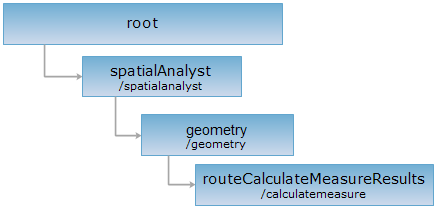
<geometry_uri>/calculatemeasure[.<format>]
Calculates the M value for specified points based on route object. A result resource for M value calculation will be returned through implementing the POST request on this resource.
Supported Methods:
Supported output formats: rjson, json, html, xml.

Implement the HTTP request on the following URI, where supermapiserver is the server name, with rjson being the output format.
http://supermapiserver:8090/iserver/services/spatialanalyst-sample/restjsr/spatialanalyst/geometry/calculatemeasure.rjson
Gets a form for the POST request.
Returns the result resource for M value calculation.
| Name | Type | Description |
| sourceRoute | Route | [Required] The route object. |
| point | Point2D | [Required] The point object. |
| tolerance | double | [Optional] The tolerance value. |
| isIgnoreGap | boolean | [Optional] Wether to ignore the distance among child objects. The default is false, indicating not to ignore the distance among child objects. |
The resonse parameters are as follows:
| Field | Type | Description |
|
succeed |
boolean | Whether the analysis result have been created successfully. |
| newResourceID | String | The ID for the analysis result resource. |
| postResultType | PostResultType |
The result type fo the POST request. |
| newResourceLocation | String | The URI of the newly created resource. |
Suppose we implement the POST request on the routeCalculateMeasureResults resource http://localhost:8090/iserver/services/spatialanalyst-sample/restjsr/spatialanalyst/geometry/calculatemeasure.rjson to calculate the M value of a specified point, the rjson format rqeust body would be as follows:
{
"sourceRoute": {
"type": "LINEM",
"parts": [4],
"points": [{
"measure": 0,
"y": -6674.466867067760,
"x": 3817.3527876130100
},
{
"measure": 199.57954019411700,
"y": -6670.830929417590,
"x": 3617.806369901500
},
{
"measure": 609.3656478634480,
"y": -6877.837541432360,
"x": 3264.1498746678400
},
{
"measure": 936.0174126282960,
"y": -7038.687780615180,
"x": 2979.846206068900
}]
},
"tolerance": 1,
"point": {
"x": 3330.7754269417,
"y": -6838.8394457216
},
"isIgnoreGap": false
}
The result in rjson format returned is as follows:
{
"succeed": true,
"newResourceID": "ejqx9g7j_a3cf1644f4fe47669272e1c3b104fd5d",
"postResultType": "CreateChild",
"newResourceLocation": "http://localhost:8090/iserver/services/spatialanalyst-sample/restjsr/spatialanalyst/geometry/calculatemeasure/ejqx9g7j_a3cf1644f4fe47669272e1c3b104fd5d"
}
Asks for the response identical to the one that would correspond to a GET request, but without the response body. This is useful for retrieving meta-information written in response headers, without having to transport the entire content. The meta-information includes the media-type, content-encoding, transfer-encoding, content-length, etc.
HEAD request can be used to check if the routeCalculateMeasureResults resource exists, or if the routeCalculateMeasureResults resource can be accessed by clients. It can also determine if the routeCalculateMeasureResults resource supports an output format <format> if performed on a URI with .<format> included.